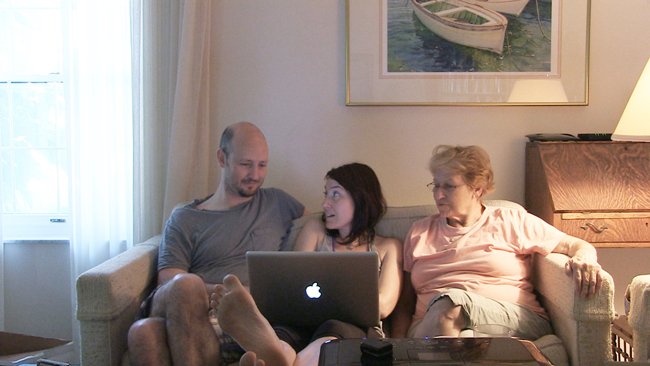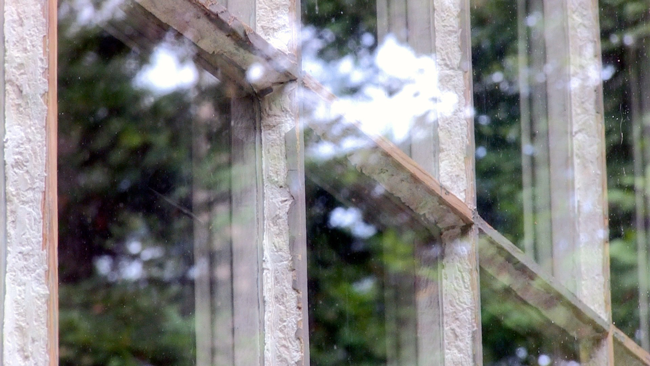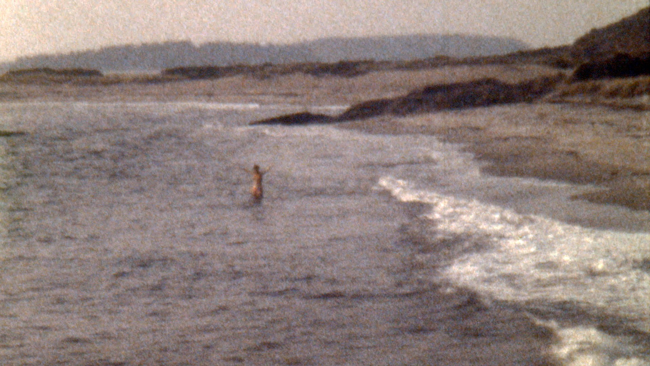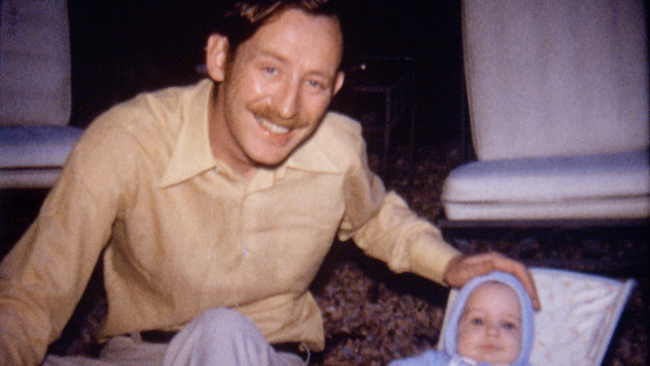Michèle Pearson Clarke
Testimonial memory is the ghost that haunts
the interstices of historical discourse.
– Jean Fisher[1]
In her 2012 book, Gentrification of the Mind: Witness to a Lost Imagination, author and AIDS activist Sarah Schulman asks, ‘where are the children of people who died of AIDS? There must be hundreds of thousands of them.’[2] In A Ghost in Our House, filmmaker Liz Gibson-DeGroote seeks to answer that question, using her camera to examine her family’s experience of her father’s death from AIDS-related complications in 1995.
A work-in-progress, A Ghost in Our House chronicles the first conversations concerning her father’s death between Gibson-DeGroote and her mother and older brother. The film follows her to her mother’s current home in Florida where she interviews her family members and searches through boxes for remnants of their past. Together, they tell two stories: one located in the past, that of their family then, beginning with her parents’ meeting and ending with her father’s death; and one in the present, that of their family now, as they finally come together to face the past.
Liz Gibson-DeGroote, A Ghost in Our House (excerpt), in process 2016, Digital Video.
Michèle Pearson Clarke: You were thirteen when your father died, so you have been living with his ghost for a long time. Why a film and why now?
Liz Gibson-DeGroote: Yes, seventeen years passed after his death before I began this project. It really took all those years to come to a place where I felt still and steady enough to take it on. And as I did, that imperative just suddenly felt very clear, probably because all these years that ghost, the weight of that whole past, was following me and hovering over everything else that I did. It was unresolved, both for me personally and in the relationships between my family members. And I think, considering the story in a wider cultural context, it’s unresolved there as well.
In terms of making a film specifically, I think I always knew that someday I would need to work this all out and express it artistically, although it was unclear what form it would take, maybe writing. But when I did get to that point when I felt ready, I didn’t consider anything but film. Maybe because I knew there would be much I don’t have words for, and so sound and image and the passing of time can step in to fill those spaces. Also the premise of making a film has acted as a necessary catalyst, and excuse almost, and a framework for encouraging these conversations and reflections in my family that were very difficult to begin.
MPC: I can only imagine. Can you talk about what that process was like, and how you negotiated your family’s participation in the film?
LGD: The beginning was fraught in a way I expected and feared. Although I had never spoken to my mother or brother about my father and that past, I knew they shared a very dark view of what happened. That’s what kept us silent for so long. So I knew that there would be a lot of pain surfacing in just bringing it all up between us. And I feared that the suggestion to make public, what in two decades we haven’t found ourselves able to discuss with even those closest to us, would seem terrible. Which, I do think initially it was. There was a lot of hesitation and some difficult misunderstandings about why I was doing this. So we proceeded cautiously, always renegotiating where it might be going. I wanted them to be sure I would respect their requests for what could be included and what could not.
But also by the time I wanted to make the film, I had been able to reform my own dark view of the past as a more objective, more compassionate narrative, realizing we didn’t need to be afraid of it. So I thought I could share that shift in thinking and feeling with my family. The process of sorting through these events, these secrets, these points of great pain, is in tandem with the process of releasing their weight and the shameful feelings we’re protecting. So I believed, and it did turn out that way absolutely, that as we moved forward, we became increasingly willing and able to share more in the film, became less protective, learning we had less to protect.

Liz Gibson-DeGroote, A Ghost in Our House, in process 2016, Video still.
MPC: These conversations between the three of you bring to mind Roger Hallas’ contention in his 2009 book, Reframing Bodies: AIDS, Bearing Witness, and the Queer Moving Image, that in AIDS autobiography, subjectivity is produced in the context of relationality. What did you come to know from balancing these relationships between the living and the dead?
LGD: Well, before I even started working on the film, I began to see that our subjective experience was very clouded by our emotions and the inability to communicate them and process them. My father had been very full of shame, and his faults, his failings, were very clear, more recognized and more easily named than any of our own. And we had reflected that shame back to him, because we all had so much pain directly tied to those failings. So he was a tragic character in that way—identified as the perpetrator within our family narrative, the one responsible.
At some point I had become able to re-evaluate our family narrative by placing it in the context of a much wider frame, starting outside our home, considering the cultural history of HIV/AIDS, and working backwards towards us—almost imagining our story from the outside. It seems a bit counter-intuitive, but I found it was easier to have clarity and compassion for everyone involved when imagining the same narrative involving strangers. And in that I was finally able to gain some perspective and begin to heal my feelings about the past and about him. I could see that it was a tragic circumstance, but also that it was very understandable that everything played out as it did; it’s all just very human. There was no perpetrator responsible for our pain, unless that perpetrator is a culture that stigmatizes AIDS and HIV, homosexual sex, alcoholism, and that has little useful and compassionate public analysis for issues of infidelity. The breakdown of a family ideal is seen as a personal failing, and is the object of shame. All these things existing outside our home were to a large degree dictating our private experience.
And throughout the process of making the film, I found that we, my mother, my brother, and I, were all equal participants with my father in the tragic outcome. I think we had assumed that all of the pain we felt was inherent in and dictated by the circumstance. When looking back, I found that the most pain was caused by our own actions and reactions within that circumstance. We were not capable of supporting each other and devastatingly, not able to really support him in his last, very difficult years—we could not be there with him in his illness and just show him love.
And it’s amazing to find that twenty years later, it’s not too late to go back and remedy these relationships between us and most significantly with my father, even in his absence. But it’s very sad that that was so impossible before he died, that his own experience could not include that resolution and the love and support that is possible within it.

Liz Gibson-DeGroote, A Ghost in Our House, in process 2016, Video still.
MPC: This return is so personal, yet by choosing documentary, I think your work is very interestingly positioned amidst the recent surge of films focused on the history of AIDS and AIDS activism. Theodore Kerr and Alexandra Juhasz refer to this cultural moment as ‘AIDS Crisis Revisitation,’ and note that this backward-looking gaze documents AIDS as a historical idea, located firmly in the past. But your film is so compelling because it challenges both past and present narratives of who is/has been affected by AIDS. Can you speak about these political aspects of the film?
LGD: I used to see my family’s experience as very separate from that public history of the AIDS crisis. In the mass of media and artworks that exist, I didn’t see my own family reflected and I think that’s why it took me so many years to make that connection, which then actually helped me to process our private experience. And once I could see it placed in that larger narrative, I realized there must be countless families like my own who remained silent and isolated from communities of support and activism. And very likely the trauma of that time is still reverberating inside many individuals and inside families, as it was in ours.
In work surrounding HIV/AIDS, there has always been an imperative to turn otherwise private information and private experience into public view, to collectively combat shame and stigma. And my intention is to contribute our story to that larger body of narratives and have it stand as case evidence for the ways that homophobia and AIDS stigma have affected families. In that effort, we reject our own shame and secrecy and stigma and that which is in the culture.
MPC: In the excerpt of your film included above, we see your mother and brother read an English assignment that you wrote in middle school, and while incredibly moving, this is just one of many archival materials that bring the past into the present in the film. What was the meaning for you behind using these documents and Super 8 movies and slide photos to tell this story?
LGD: When I was filming, I found all of this stuff at my mother’s house and I had actually never seen any of that material before—I didn’t even know we had Super 8 movies and I discovered my father had written some diaries. So seeing all these artifacts, evidence of that time and who we were and what happened, was as transformative as any other part of the process. They’re puzzle pieces, all these individual bits that I could fit together to discover this story, and then to share with a viewer. Our memories may be fallible, but these are indexical links to that time. In the case of my father, some of his words and images of him, are the only available to represent him directly, the only clues to his experience.
And absolutely, as you mention, they bridge the past and the present; and most importantly, particularly in the case of writings I found, sharing them between us was a way to join our isolated experiences, a way to retroactively make a shared experience out of these fragments that had been unnecessarily disjointed at the time. Our individual stories that had only run parallel to each other are combined to make one story of a family that none of us had really seen clearly before. That was important.

Liz Gibson-DeGroote, A Ghost in Our House, in process 2016, Video still.
MPC: Place and landscape play important roles aesthetically in both these older materials as well as in newer footage that you shot yourself, particularly the ocean and the house where you grew up. Representationally, this seems to locate your remembrance firmly in the domestic and in the familial only, rather than in the public and in the communal, which are more common visual representations of HIV/AIDS during the 1980s and 1990s. How are these locations related to your memories of your father and what functions do you intend them to serve in the film?
LGD: In a way, I felt like these spaces, the backdrop to everything that happened, had been holding the story for all these years and we ignored them. We were always near the water. My family, and particularly my father, loved being on the ocean and the beach. It’s a very integral part of each of our lives from that time, so it’s something that binds us together and aesthetically tells a bit about us personally.
The film refers to the cultural experience of HIV/AIDS mostly in how its social construct and its stigma influenced our private lives and relations, but you’re right, it does express a very domestic, insular experience with the disease. It’s located in the experience of home, childhood and family. And I use those aesthetics of the house I grew up in and also the house where my mother lives now, the past and the present, intending that not only will people who may share similar experiences connect to our story, but also that people who maybe would not otherwise relate with the public experience of AIDS can likely relate with the experience of home, childhood and the good, difficult, complicated experience of family, and through that be able to connect with these issues.
There’s also something about the ocean always being there, almost another living thing that witnessed us, and that took all that on, but in its massive expanse and its eternal consistency, it absorbs and diffuses everything a bit. The fact that it just keeps rolling, no matter what the domestic and private trials of our lives is powerful. Our lives seem little in comparison and there’s comfort in that. And in the film, it works similarly I think, and maybe some of the visuals of the home too, giving some space to be able to take the intensity of human experience.

Liz Gibson-DeGroote, A Ghost in Our House, in process 2016, Video still.
MPC: You completed a version of the film for your MFA thesis in 2014, but I know that you have continued to work on it since then. What are your plans for a final version and what are your hopes for a premiere in the future?
LGD: While I did complete a version of this film for my MFA, I found tying the entire production to that schedule to be difficult, and I wanted to take some time away before returning to it with some fresher perspective. I’m just going back into editing a new cut and hope the film will be finished in the fall. At that point, I’ll submit to festivals.
A premiere in Toronto would be nice as it’s where so many of the people who’ve supported my efforts are located. In general, I just hope it can reach a wide audience and although reaching people who do not share a personal history with HIV/AIDS is important to me, it’s probably most exciting to me that people who do share similar stories to my family’s see this film and connect with those reflections of their own experience.
[1] Jean Fisher, ‘In Living Memory… Archive and Testimony in the Films of the Black Audio Film Collective’, in Eshun, Kodwo and Angalika Sagar (eds.). The Ghosts of Songs: The Film Art of the Black Audio Film Collective, 1982-1988 (Liverpool: Liverpool University Press, 2007), 17.
[2] Sarah Schulman, The Gentrification of the Mind: Witness to a Lost Imagination, (University of California Press, 2012), 48.
Liz Gibson-DeGroote is a filmmaker and video artist from New England, now settled permanently in Toronto. Her work often explores emotional relationships to landscape and between people. She holds a BFA from the Studio for Interrelated Media at Massachusetts College of Art and Design and an MFA in Documentary Media Studies from Ryerson University.
Michèle Pearson Clarke is a Trinidad-born artist who works in photography, film, video and installation. Using archival, performative and process-oriented strategies, her work explores queer and black diasporic longing and loss. Her work has been shown nationally and internationally including at the Ryerson Image Centre, The Power Plant, Images Festival, International Film Festival Rotterdam and International Short Film Festival Oberhausen. Currently based in Toronto, she holds an MSW from the University of Toronto and an MFA in Documentary Media Studies from Ryerson University.